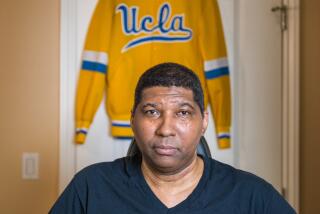A Triumph of Will : Howard Thomas Hasn’t Let Illness Destroy His Zest for Life
- Share via
At the age of 29, Howard Thomas of San Pedro has so far beaten the odds against muscular dystrophy, a disease that usually leads to a patient’s death by the early 20s.
Thomas has taken those extra years to focus on raising money and educating the public about the disease he has lived with nearly all his life.
“[Living with muscular dystrophy] is not rosy,” Thomas said. “I go through pain, but isn’t it better to live and do something?”
Rather than dwelling on the slow deterioration of his body, Thomas spends his days organizing an annual fund-raising event to benefit the Muscular Dystrophy Assn. and writing a book on his experience living with Duchenne muscular dystrophy, a form of muscular dystrophy that usually strikes boys.
On Labor Day, Thomas will take part in the Jerry Lewis Telethon, appearing on a local broadcast for the nationally televised show to help raise money to find a cure for the disease. But he focuses most of his energy on the grass-roots fund-raiser he founded three years ago, the Howard Thomas San Pedro Sampler benefit. Last year, the event raised $27,000, and organizers expect to exceed that amount this year.
The fund-raiser, set for Oct. 1 at the Princess Pavilion in San Pedro, will feature wine tasting, food sampling from various local restaurants, a silent auction and a live auction. The fee is $30 per person.
Thomas works year-round on the event, spending up to 50 hours a week hounding companies and organizations to donate money. This year the event will feature guest appearances by members of the Women’s Professional Volleyball Assn.
“Beyond the money they raise for the MDA, the community focus of it is just super,” said Frank Krampe, district director of the Southeast Los Angeles Muscular Dystrophy Assn. “It is just amazing how much time he puts into this, given his condition. But that is why the event is so successful,”
Thomas, who is the youngest of three siblings and lives with his parents, Jack and Claire Thomas, prefers to talk about his activities, not the tracheotomy that allows him to breath, or the full body brace that keeps him upright in his wheelchair, or the feeding tube that flows to his stomach.
Found to have the disease as a toddler, he could no longer walk by the age of 10 and has since relied on a wheelchair for mobility. Yet the disease has failed to dampen his enthusiasm for life.
Initially, Thomas attended a school for disabled students but was one of the first students to be “mainstreamed” into Dodson Junior High School in San Pedro and Narbonne High School in Harbor City.
“At the special school, I did not have the classes I needed to go on to college. I was going nowhere. I needed to be challenged,” Thomas said.
At Dodson and at Narbonne, Thomas said, he occasionally endured cruel teasing by some classmates. One student would steal his wallet, turn off his electric wheelchair and take his books. By his senior year, however, he had found his niche, eventually deciding to run for student body vice president and winning.
“He was disappointed [when people teased him] but he bounced back,” said Chet Hanley, a close family friend and former counselor at Willenberg Special Education Center, Thomas’s first school. “Like any trailblazers, they had to deal with rejection and being perceived as weird or different.”
But his biggest challenge came five years ago when a respiratory illness, triggered by the muscular dystrophy, almost killed him. He survived a series of operations but went through months of depression and pain. But with his family’s care and support, Thomas was able to break through the depression.
“[His death] is something that we expect--we don’t know when, but we have to be ready,” said his father, Jack Thomas, a retired professor of physiology. “Every day he wakes up alive, we are grateful.”
Thomas seems to share that philosophy--and it is one of the catalysts behind his fund-raiser.
“I know what has happened to me and nobody should have to go through what I went through,” Thomas said. “They are so close to finding a cure for this disease, I want to help kids who may want to be able to play sports, like I did.”
Sometimes, he said, he is fearful that the medicine he uses to stabilize his heart will stop working. But he tries not to think about that. “I decided that I’ve survived so many years, that I might as well keep on going.”
More to Read
Sign up for Essential California
The most important California stories and recommendations in your inbox every morning.
You may occasionally receive promotional content from the Los Angeles Times.










